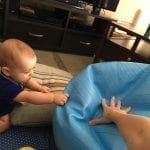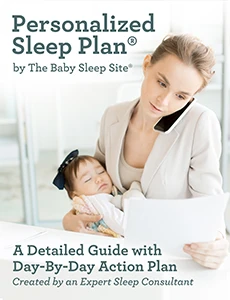
Let’s face it. Accidental co-sleeping is real! You know the kind of co-sleeping I’m talking about, right? The kind of co-sleeping that you never really planned on, but that just kind of happens on its own? The kind of co-sleeping where you put your child to sleep in her own bed, only to find her in YOUR bed a few hours later?
Yep. That kind of accidental co-sleeping.
Sure, plenty of parents co-sleep intentionally, out of a desire to practice attachment parenting principles. But based on our work with parents, I’m willing to bet that there are just as many accidental co-sleepers out there as there are intentional co-sleepers.
And that’s who we’re talking to in today’s post! We’re talking to you, accidental co-sleepers! Keep reading for tips and facts about accidental co-sleeping.
The Accidental Co-Sleeper: 5 Key Facts
1. Accidental co-sleeping does not equal failure.
It’s easy to feel like you’ve failed at your goals if you “give in” and let your child sleep with you. However, we’d urge you not to be too hard on yourself.
If you need to co-sleep for a season (even though you never intended to do so) because, it makes nursing easier, or to get through a tough illness, that’s okay. Many families find themselves in this position.
That said, it’s good to be aware that when you co-sleep “accidentally” (especially if you do it for weeks at a time), you are mostly likely creating a new sleep habit that you will have to undo at some point down the road if you decide you want to sleep solo again.
2. Accidental co-sleeping can turn into intentional co-sleeping. (Or it can turn into a need to STOP co-sleeping!)
Some families that start out as accidental co-sleepers actually find that they love co-sleeping! These families often become intentional co-sleepers who build their lives around sharing a sleeping area with their kiddos. But just as many accidental co-sleepers really don’t like co-sleeping. Their kids, however, usually feel differently, and so accidental co-sleepers who fall into this category tend to end up with a co-sleeping problem on their hands. This typically requires sleep coaching and transitioning to separate sleeping areas.
3. Safety is crucial for accidental co-sleepers who share a bed.
Now remember, co-sleeping can mean either sharing a room or sharing a sleeping space (like a bed). Keep in mind that if you are an accidental co-sleeper who shares a bed with your little one, you will need to be extra-diligent about co-sleeping safety. Many intentional co-sleepers are well-aware of co-sleeping safety standards well before they begin co-sleeping and are more likely to take proper safety precautions. Precautions can mean moving the mattress to the floor, removing all loose bedding and pillows, and abstaining from alcohol. Accidental co-sleepers, on the other hand, are far less likely to take these precautions since co-sleeping tends to happen on-the-fly, in a tired middle-of-the-night moment. For this reason, it is so important to take proper safety precautions NOW, since you will no doubt be sharing your bed with a child again soon.
4. Accidental room-sharing is an alternative to accidental bed-sharing.
Now, if that last bullet point about safety has you concerned, don’t worry. You can have the convenience of co-sleeping without the risks! Instead of hosting your child in your bed, host him in your room, near your bed. You can put your baby in a bassinet or portable crib next to your bed. You can put your toddler on a small mattress or sleeping bag near your bed. This offers you the convenience of having your child nearby for nursing or soothing. It also ensures that you don’t have to worry about following any bed-sharing safety standards that could feel burdensome.
5. Accidental co-sleeping doesn’t have to happen in YOUR room… It can happen in your baby’s nursery.
This point takes lots of parents by surprise, but here it is. Co-sleeping works just as well in your child’s room as it does in your own! In fact, we think it’s a great in-between option for parents who don’t really want their children sleeping in their beds, but who do find that co-sleeping helps everyone sleep better.
Here’s how this works… You put a mattress on your child’s floor, right by your child’s bed. You can share this with your kiddo, but it usually works just as well (and is safer) if your child stays in her own bed. This works because you can both sleep comfortably, and you have the power to come and go as you need to.
If you are able to move away to your own bed in the middle of the night, great! If you manage a few nights of independent sleeping in different rooms for a night or two, awesome! When you sleep in your child’s room, you end up with more flexibility and freedom. Additionally, if you do hope to avoid creating long-term co-sleeping habits, this is a great option, as it prevents your child from associating your bedroom with sleep and instead helps him to associate his own bedroom with sleep. This makes it much easier to transition away permanently from co-sleeping. You simply decrease your time in your child’s room until you are only in there during the bedtime routine.








